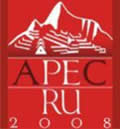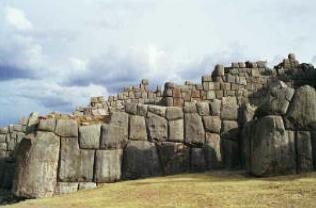United Kingdom
| Welcome |
| Peru in Brief |
| History |
| Geography |
| Government & Politics |
| Maritime delimitation between Peru and Chile |
| News |
Links |
| THE INCAS | |||
| (Sacsayhuaman Fortress) | |||
The various cultures which flourished in ancient Peru either disappeared or were vanquished by the Incas, whose appearance is located around A.D. 1000. The Incas made remarkable advances in numerous branches of engineering, as attested by their buildings, roads, bridges, aqueducts and monumental sites, such as the fortress of Sacsayhuaman and the citadel of Machu Picchu. |
|||
The Incas' hydraulic expertise included techniques for converting mist into water for irrigation, something which enabled them to farm extensively what today is Peru 's arid coastline. Their language, Quechua, is Peru 's second official language alongside Spanish. Evidence from quipus, or knotted strings, suggests that the Incas also possessed a writing system, though its workings still puzzle scholars. |
|||
For political and administrative purposes, territory was divided into wards containing 10, 100, 1000 and 10,000 residents, each supervised by appointees of the Inca ruler. We thus know that the Incas were acquainted with the decimal system as early as the 11th century A.D. |
|||
The Empire established itself in an area comprising the basins of Lake Titicaca and the Urubamba river. The heart of Inca power and the seat of government were situated in the middle of the so-called Sacred Valley or Valley of Cuzco. |
|||
Oral traditions gathered by the Spaniards from the quipucamayocs (imperial officials trained in quipu strings) contain accounts of the empire's foundation. The best-known among these, probably Garcilaso in his "Royal Commentaries", is recapitulated below. |
|||
As the Sun had taken pity on mankind for its savage state. "They ate the herbs of the field and roots or fruit like wild animals, and also human flesh. They covered their bodies with leaves and the bark of trees, or with the skins of animals", he sent down a son and daughter to give people religion and the Sun cult, precepts and laws, and to teach them to live in houses and towns and to grow crops and breed animals to enjoy together the fruits of the earth. The Sun placed this couple in Lake Titicaca , whence they should set out and seek a place to settle. He gave them a golden rod to thrust into the ground wherever they might stop, so that where the rod should sink and disappear, they must remain and build a new kingdom. |
|||
Trying as they did to sink the rod in different places, they came upon the hill called Huanacaure, south of the city that was to be. "It was here that the sceptre of gold buried itself in the ground with great ease, and it was never seen more." Then the Inca said to his wife and sister: "Our Father the Sun orders that we settle in this valley to fulfil his wishes. It is therefore right, O queen and sister, that each of us should gather these people together, to instruct them and to do the good which has been ordered by our Father the Sun." Thus the king went northwards, and the queen to the south. Seeing these two personages attired and adorned with the ornaments which the Sun had given them, their ears bored and covered by great earflaps, and seeing "that, from their words and appearance, they seemed to be children of the Sun", the savages acknowledged the strangers and obeyed them as their kings. Having spread the word amongst themselves, men and women assembled in great numbers and set out to follow the kings wherever they might lead them. "In this manner [the king] began to settle this our imperial city, dividing it into two parts, called Hanan Cuzco, which, as you know, means Upper Cuzco, and Hurin Cuzco, which is Lower Cuzco. The people who followed the king wished to settle in Hanan Cuzco, and for that reason it received the name; and those who were gathered together by the queen settled in Hurin Cuzco, and it was therefore called the Lower Town . This division of the city was not made in order that those living in one half should have any pre-eminence or special privileges, for the Inca desired that all should be equal like brothers - the sons of one father and one mother. He only wished to make this division into an upper and a lower town, that there might be a perpetual memory of the fact that the inhabitants of one were assembled by the king, and of the other by the queen." Manco Capac instructed the men in the arts and trades pertaining to their sex. He taught them how to sow crops, how to distinguish useful from worthless plants, and how to make ploughs and channel water from streams; he even taught men how to fashion their own sandals. Mama Occllo for her part trained the women in such occupations as spinning and weaving cotton and wool, and making clothes for themselves, their husbands and children. In sum, "our princes taught their first vassals everything that is needful in life, the Inca making himself king and master of the men, and the Coya being queen and lady of the women". (First Book of the Royal Commentaries, Chapters XV-XVI) |
|||
| <BACK> | |||






